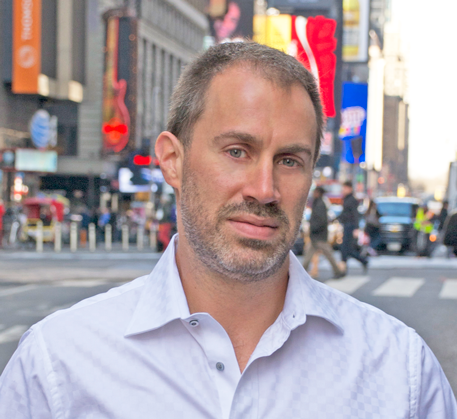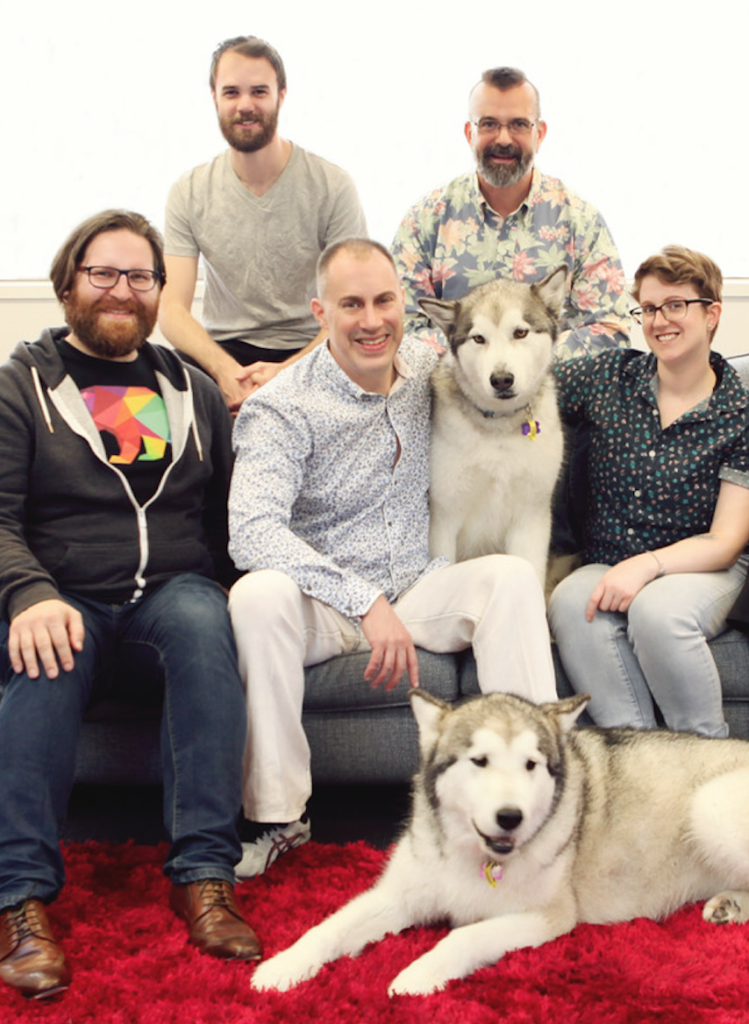Every quarter our principal Chris Humphreys does a deep dive into the back story of one of our founders. This quarter, it’s about Stephen Pool, CEO of Core Schedule.

Let me introduce to you Stephen C. Pool: entrepreneur, Alaskan Malamute owner and the founder of Core Schedule. But that’s not all, Dr Pool is also an Emergency Medicine Specialist. You know – the guy that patches you up when you have an accident, or in my case, when your oldest son accidentally guillotines the end of your youngest sons finger in a door (I won’t go into the gory detail, but we did need a helicopter ride to the hospital).
It’s not a job that I could ever do – I have a thing about needles. Apparently, you also need some type of qualification and apparently a finance degree just won’t cut it.
But let me take you back to the start of the Core Schedule story. To do that we need to go back to late nineties New York, a place of crime, grime, and bulletproof glass in taxis. It was in this setting that a fresh-faced Stephen had just come out of New York University and started his emergency medicine residency at Bellevue Hospital.
Sleep is Optional
We’ve all seen the TV shows – residency is gruelling work. Long shifts, 100+ hour weeks and being at the bottom of the pecking order are all part of the job. Most people in that situation would usually just put their head down, focus on the job at hand and get on with it. But not Stephen. With an interest in computers and programming that can be traced back to his childhood in Mobile, Alabama, Stephen continued to tinker and learn new programming languages, and was continuously on the lookout for ways to apply his knowledge. In the end, he decided that it would be a good idea to set up an internet start-up partway through his residency.
It sounds like sleep was obviously an optional nice-to-have for Stephen back then! Medical Web Solutions specialised in developing websites for GP offices. Back then the World Wide Web was still in its infancy, so there was plenty of opportunity to grow and Stephen made the most of it. It started with basic websites for friends and colleagues who were willing to pay for it, and then got more sophisticated and attracted new customers. The company’s software got better too, and Stephen started looking to building in billing functionality, where he saw a lot of potential. The business was growing really well, even to the point where Stephen was having advanced discussed with US venture capital funds about raising money to expand the business. Then it happened.
Bubbles Always Burst
For those of you that are old enough, you will remember the terms like “dot-com bubble” and “tech wreck” that were in common usage at the turn of the millennium. They refer to a period when there was a lot of speculation in internet-related businesses and those companies’ valuations were sky-high. In 2000, those valuations crashed and sent those businesses out of business. For Stephen it meant a double whammy of no venture capital funding and sales drying up. Medical Web Solutions was dead in the water. That hurt. Stephen had been funding the business up to that point out of his own pocket and found himself in a serious hole. Stephen took stock and decided that it was time to refocus purely on medicine. He completed his residency and then worked in a number of hospitals around New York.
Things We Love to Hate
It was at one of these earlier jobs that the painfulness of hospital rostering was made clear to Stephen. He wanted to take leave and when he asked how to go about it, he was handed a transparency (that’s a clear plastic piece of paper used for overhead projectors, for those born more recently than Lance) that had a bunch of red lines on it and then another form which had some sort of calendar on it, along with a two-page list of instructions. It worked by holding the calendar up to a window and moving the transparency across it in a certain way until you find a spot on the calendar that lines up with a certain line on the transparency. This represented the days when you could actually take leave. So Stephen took it home and it took him and his husband 30 minutes to figure out how it was supposed to work. Not much later at work there was a discussion about their leave system and Stephen mentioned that the current system was really embarrassing. Their response was “well, if you think you can do better, have at it…”
Oh… It’s On!
That single comment made eleven years ago was a red rag to a bull. The system was about to be computerised and Stephen had the right programming skills and the medical experience to do the job. This overhaul started as an online system to request leave, which was followed (after requests) with work scheduling outputs so staff could see more easily when they were rostered on to work. Over the next two years, Stephen built the first iteration of what would become the Core Schedule software. Stephen treated this as a hobby project in the early days. Initially the software was only used in his department, but pretty soon the doctors that were using it at his hospital would ask Stephen about building a system for other hospitals where they also worked.

Some of the team: Richard Girvan, Cade Murphy, Stephen, Neil Thornton, Penny Latey and the two brains of this outfit, Logan and Gambit.
With organic demand increasing, the amount of time that Core Schedule required became too much for Stephen to manage alone, so he engaged a developer from a firm in India to do a lot of the basic programming and software updating. By this point Core Schedule was being used by single departments across a dozen hospitals.
A Year of Big Decisions
2013 was a pivotal year for Stephen. He had just married long-time partner Neil and they were deciding where to go for their honeymoon when they saw an ad the weekend after the wedding for a South Island action adventure/white-water rafting tour. It was an easy decision to come to New Zealand for a holiday and when they arrived they fell in love with the country. They had no thoughts of living here at that point, thinking that it wouldn’t be possible. After the honeymoon, Stephen went back to work in New York and was raving to a colleague about like how much he loved New Zealand, how much fun they had and how great the people were. His colleague responded that it is actually really easy for American doctors to go and practice in New Zealand. Stephen’s immediate response was that he was too old to re-sit his medical exams again, but his colleague said that wasn’t an issue. New Zealand would recognise his American certification as being equivalent to the New Zealand certification, and all he would need to do is pay the fees and jump through a lot of administrative hoops.
That was news to Stephen, and he later found out that of all the other countries in the world, only New Zealand and Australia has this recognition arrangement for American doctors in place. He looked into it and found there were a lot jobs available in emergency rooms in New Zealand, with many of them for six month terms. So a plan was hatched to come to New Zealand – a sort of a six month working vacation. A position in Wellington became available and once the decision was made to take it up, they had 32 days to sell all of their stuff in New York and make the move.
Stephen didn’t really know what he was getting himself into with the New Zealand health system. He wasn’t expecting it to be as modern as the US system, but he what he actually found was actually on a par. He was shocked by his first day working in the Wellington Emergency Department. He recalls that apart from the accents, you wouldn’t be able to tell the difference between Wellington Hospital and any other ER in the US – the skills and the training were probably better and we have all the equipment you would expect to see in a US emergency room. The set up was also very similar in terms of how it was equipped and how it was operated – right down to the staff rostering system.
The only things that were different was the lack belligerent patients on PCP, the heroin overdoses and the people threatening to shoot you, which was a daily occurrence in New York.
It’s All Good
The six months in Wellington was a great experience. So good in fact, that Stephen and his partner pondered why they ever would go back to the US. Sure, the pay was about 50% lower in New Zealand, and the cost of living was about the same, but Stephen had long paid off his student debt in the States, so didn’t need to earn a whole lot. And Stephen was ready for a change. The constant stress, lower staffing levels and the sicker patients in the US weren’t worth thinking about (not to mentioned that he would be up to his eye-balls in COVID-19 patients if he had stayed). So as you do, they bought a house, got dogs and went through the immigration process. This raised a question of what to do with Core Schedule.
By that point, the ER department at Wellington Hospital was their only non-American customer (Stephen was in charge of the roster there and said if he couldn’t use Core Schedule, he wouldn’t do the rostering). Up to then, Stephen had never marketed Core Schedule, so they decided that they should go to a medical conference as a vendor to do so. So Stephen and his husband went to Australasian Emergency Medicine Doctors conference, got a table, and handed out flyers that they had made up the night before.
All In
In that single conference, they doubled the size of the business overnight and started thinking, wow, we actually might be on to something here. They went to that same conference the following year and the exact same thing happened. It was at this stage that Stephen realised that Core Schedule was now too big and running too fast to operate as a hobby business anymore. Eight years in, Stephen knew that he needed to decide what to do with the business. It wasn’t going to work to put a manager in the business, so it was either sell it or fully commit himself.
Realising that he was having more fun doing Core Schedule than clinical medicine, it was time to go into pure start-up mode. Their first New Zealand hire was software developer Richard, who Stephen’s husband had first met in a bar. When they worked out that Richard had php programming experience, he was invited in for an interview. Richard wasn’t sure what he was turning up for – he thought maybe some casual or contracting work. Immediately after the interview he was offered a permanent full-time job on the spot and has been with Core Schedule ever since.
The Build Up
At this stage Stephen was spending most of his time on sales. The next two hires for the business where Vaughan, a business development manager, and Nicole, a finance manager. They found Vaughan through a friend of a friend. And they knew a partner of a doctor that Stephen worked with that had a finance background – that was Nicole. The company had that team for the next year as the business continued to grow. Soon after, they hired a fulltime support person and another software developer. At that stage, there were seven people in total, all working out of Stephen’s home, which kept the costs down. That arrangement lasted for a year before they bit the bullet and moved into their current office. That was two years ago, a time when the company was generating around $200,000 in annual revenues. Since then revenues have more than doubled and in June Core Schedule took its first round of external funding, lead by Punakaiki Fund, along with investment from K1W1 and the Aspire NZ Seed Fund (part of the Government’s NZ Growth Capital Partners). In these COVID times, the company has a unique opportunity to help manage health workers through these stressful times. While selling the Core Schedule software has become harder in the short-term (because of travel restrictions), the future is looking bright for this ex-US start-up.
Visit Core Schedule here.
